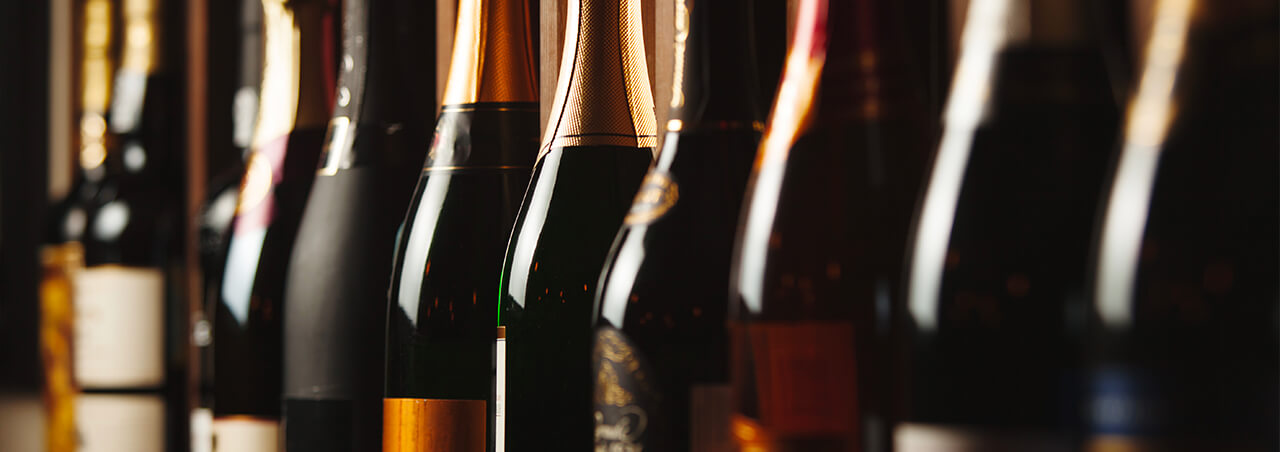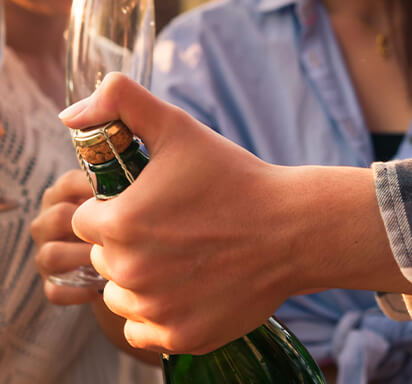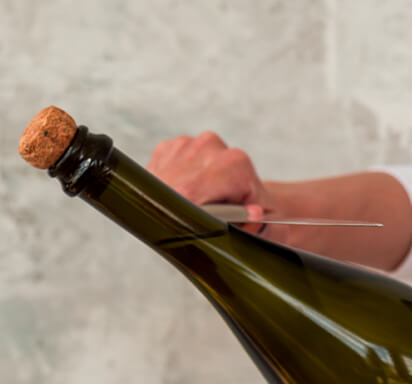Types of Champagne: The many faces of Champagne

Seeking a bottle of champagne for a special occasion but not sure which style to choose? We hear you. Champagne is one of the most complex styles of wine, available in a wide range of colors and at many different sweetness levels.
Seeking a bottle of champagne for a special occasion but not sure which style to choose? We hear you. Champagne is one of the most complex styles of wine, available in a wide range of colors and at many different sweetness levels. We’re sure you’ve seen designations like “vintage,” “brut,” “blanc de blancs” and “vieilles vignes” on a bottle of bubbly. But what do these words actually mean? In this article we take a look at the many different types of Champagne and how to categorize them!
BY COLOR: WHITE, ROSÉ, BLANC DE BLANCS AND BLANC DE NOIRS CHAMPAGNE
First things first, color. As with all wines, the color of a champagne is determined by the grape varieties and the winemaking techniques used in the production process. Most champagne is made from all three Champagne grapes – Pinot Noir, Chardonnay and Pinot Meunier – and vinified as a white wine, without maceration of the must on the grape skins. These champagnes – like the Moet & Chandon Champagne Brut Imperial - offer a wide range of aromas, like stone fruit and citrus.
Rose champagne is a champagne that is vinified as a rosé and sports a pale to deep pink color in the glass, sometimes with orange reflections. Rosé champagne can be produced either by allowing the must to macerate in red-skinned grapes (Pinot Noir or Pinot Meunier) or by blending red and white base wines from Champagne. The latter is more common. Rosé champagnes come in a wide range of flavors, often exuding red fruit and pink grapefruit aromas on the nose.
Sparkling wines produced in the region of Champagne in France, exclusively from white grapes – namely, Chardonnay – they are called Blanc de Blancs Champagne. This translates to “a white from whites”. Some of the greatest champagne brands in the world, like Ruinart Champagne, is known for its exceptional 100% Chardonnay Blanc de Blancs cuvees.
These champagnes offer fresh floral fragrances, which blend with stone fruit and exotic fruit aromas. On the palate, they also reveal a distinctive chalky minerality.
When a sparkling wine produced in the Champagne region of France is made exclusively from red grapes – Pinot Noir and/or Pinot Meunier – but vinified as a white wine, it is a Blanc de Noirs Champagne. This translates to “a white from reds”. Removing the grape skins, rather than allowing the must to macerate with them, leads to a lack of red color in the wine.
Brands like Bollinger, who consider Pinot Noir their flagship, produce fantastic Blanc de Noirs cuvees. These champagnes can be quite powerful with earthy and mineral aromas.
And what about Noir de Blancs Champagnes? Trick question, they do not exist! There is no known way to make a red or pink wine from the white grapes variety of Chardonnay. Looking to learn more about these different styles of champagne vs sparkling wine? Discover our article entitled Sparkling Wine vs Champagne.
BY DOSAGE: BRUT NATURE, BRUT, EXTRA DRY CHAMPAGNE AND DOUX
Different types of champagne can also be categorized by dosage or sweetness, which is determined by winemaking choices. After several months or years of aging on lees, the wine for champagne is disgorged to remove the dead yeast. Before the champagne bottle is corked, it is topped off with a small amount of “liqueur d’expédition.” This liquid is added as a “final touch” or as a corrective measure. It contains the same wine that is in the bottle or a reserve wine, as well as a “dosage” or dissolved sugar.
The dosage varies from 500 to 700 grams of sugar per litre and determines the sweetness of a champagne. The different types of champagne by dosage, from sweetest to the driest are:
• Doux = more than 50 grams of sugar per liter
• Demi-sec = 32-50 grams of sugar per liter
• Sec = 17-32 grams of sugar per liter
• Extra Dry= 12-17 grams of sugar per liter
• Brut = less than 12 grams of sugar per liter
• Extra brut = 0-6 grams of sugar per liter
• Brut nature = 0-3 grams of sugar per liter
Today, the most popular style is Brut Champagne, with the average dosage hovering around 8 grams per liter. Nevertheless, there are several Champagne Houses, such as Drappier Champagne and Billecart Salmon Champagne, producing exquisite very dry champagne in the Brut Nature style in this Appellation d’Origin Controlee. Discover also the Ace of Spades Brut Gold Champagne!
BY HARVEST YEAR: NON-VINTAGE AND VINTAGE CHAMPAGNE
Champagne can be categorized by the year in which the grapes used in its blend were harvested.
Vintage champagne is produced with grapes harvested in the same year. By appellation law, vintage champagne must be aged for a minimum of 3 years in the bottle, as opposed to the 15 months required for their non-vintage counterparts. This leads to remarkable complexity on the nose, brought by autolytic aromas of brioche, toast and butter.
Vintage champagne from top brands like Dom Perignon or the Louis Roederer Champagne Cristal cuvee represent some of the best champagne in the world.
Non-Vintage champagne, representing 95% of the Champagne region’s production, is made from grapes harvested in more than one vintage. Base wines from older vintages kept as “reserve wines” are blended with the current vintage. Rather than expressing the unique character of a single vintage, these champagnes express a brand’s signature style, consistent from year to year. There are many exceptional non-vintage champagnes, including the legendary Krug Grande Cuvee.
Some champagnes, such as the Champagne Laurent Perrier Grand Siècle cuvee, blend base wines produced from a limited number of vintages. The Laurent Perrier Grand Siècle Iteration 25, for example, blends fruit from 2008, 2007 and 2006.
BY ORIGIN: MULTI-VINEYARD, SINGLE-VINEYARD AND VEILLES VIGNES CHAMPAGNE
Most champagnes are blend of multiple grape varieties from multiple vintages and from multiple vineyards. Multi-vineyard champagnes offer a great overall view of the Champagne region, with the various terroirs expressed each adding its own signature characteristics to these sparkling wines.
A select few very special champagnes, however, are made with grapes harvested from the same vineyard or plot. In the case of these champagnes, the name of the vineyard of origin - usually a prestigious Premier Cru or Grand Cru in the Cote de Blancs, Montagne de Reims or Vallee de la Marne - will be displayed on the bottle.
Philipponnat Champagne was famously the very first great Champagne House to market a product (its Clos des Goisses cuvee) as a single-vineyard champagne. These champagnes express the unique qualities of their terroir of origin and are often vintage champagnes.
Finally, the “Vieilles Vignes” designation displayed on the label of some champagnes signifies that the grapes used to produce it come from old vines. Many Vieilles Vignes champagnes are also single-vineyard vintage champagnes, and tend to express a greater concentration of aromas, stemming from the naturally low yield of these vines.
SPECIAL EDITION CHAMPAGNES FOR COLLECTORS
For avid fine wine collectors and customer seeking a wine gift to be remembered for a lifetime, the top Champagne brands have also created a range of rare special edition champagne bottles. Brands like Veuve Clicquot Champagne are especially well-known for their creative packaging choices, which redefine what is champagne and allow for a wide range of unique tasting experiences.
Brands like Louis Roederer and Dom Perignon have also teamed up with artists like Lady Gaga and Philippe Starck to create unique limited edition labels and gift boxes, the perfect champagne gift for any fine wine lover. Other brands produce a rare prestige cuvee bearing the names of their founders or historical figures, like Sir Winston Churchill. These champagnes are often available in their very own champagne gift boxes.
Asking yourself “But where do I find these champagnes near me?” ? Browse our website or visit our NYC boutique to find them! Have any questions about the different types of champagne? Our talented team of wine experts is always available to guide you through our selection and help you choose the right champagne type to suit your preferences!
You may like
Unveil the unique characteristics of Champagne Blanc de Blancs and Blanc de Noirs. Learn how these two styles differ in flavor, grape varieties, and food pairings to elevate your Champagne experience.
12/19/2024Discover how Chardonnay, Pinot Noir, and Pinot Meunier shape the distinct character of Champagne. Learn about rare grape varieties and explore notable examples from top producers in the world’s most famous sparkling wine region.
7/4/2024To help you safely open a bottle of bubbly, we have put together a guide with 6 simple steps. Learn more about when to open a bottle of Champagne and how to do it in the safest and most graceful way.
3/11/2023A swift swoop of the knife along the neck of the bottle, followed by a “pop!” as the glass shatters and the “hiss” of the Champagne as it flows out. There is no more festive way of opening a bottle of Champagne than by sabering it
3/8/2023Guardian of the bottle and the precious bubbly inside, the cork serves an essential role in the preservation of Champagne. Over the years, it has evolved and adapted to this very special role.
3/6/2023What is the best way to store Champagne or sparkling wine for the short or long term? Find here best storage practices, which will help keep your bottle of bubbly Champagne or sparkling wines fresh for as long as possible.
2/20/2023










